

Compact Muon Solenoid
LHC, CERN
| CMS-HIN-21-006 ; CERN-EP-2022-280 | ||
| $ \mathrm{K^0_S} $ and $ \Lambda $ ($ \overline{\Lambda} $) two-particle femtoscopic correlations in PbPb collisions at $ \sqrt{\smash[b]{s_{_{\mathrm{NN}}}}} = $ 5.02 TeV | ||
| CMS Collaboration | ||
| 13 January 2023 | ||
| Phys. Lett. B 857 (2024) 138936 | ||
| Abstract: Two-particle correlations are presented for $ \mathrm{K^0_S} $, $ \Lambda $, and $ \overline{\Lambda} $ strange hadrons as a function of relative momentum in lead-lead collisions at a nucleon-nucleon center-of-mass energy of 5.02 TeV. The dataset corresponds to an integrated luminosity of 0.607 nb$^{-1}$ and was collected using the CMS detector at the CERN LHC. These correlations are sensitive to quantum statistics and to final-state interactions between the particles. The source size extracted from the $ \mathrm{K^0_S}\mathrm{K^0_S} $ correlations is found to decrease from 4 to 1 fm in going from central to peripheral collisions. Strong interaction scattering parameters (i.e., scattering length and effective range) are determined from the $ \Lambda\mathrm{K^0_S} $ and $ \Lambda\Lambda $ (including their charge conjugates) correlations using the Lednicky-Lyuboshitz model and are compared to theoretical and other experimental results. | ||
| Links: e-print arXiv:2301.05290 [hep-ex] (PDF) ; CDS record ; inSPIRE record ; HepData record ; CADI line (restricted) ; | ||
| Figures | |
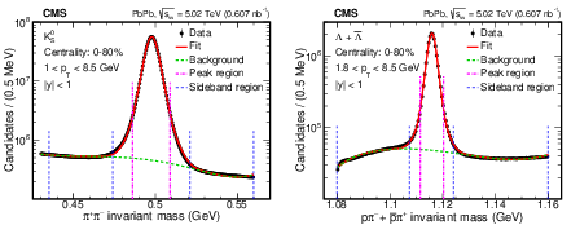
png pdf |
Figure 1:
The invariant mass of $ \mathrm{K^0_S} $ (left) and $ \Lambda $ (right), and their corresponding fits in the 0-80% centrality range. The circles are the data, and the fit is shown with a solid (red) line for the total fit, and a dashed (green) line for the background fit. The vertical dashed-dotted (pink) lines indicate the peak region and the vertical dashed (blue) lines indicate the sideband regions. |
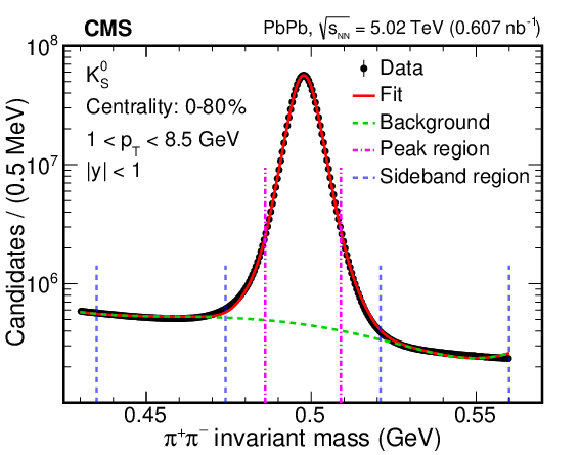
png pdf |
Figure 1-a:
The invariant mass of $ \mathrm{K^0_S} $, and the corresponding fit in the 0-80% centrality range. The circles are the data, and the fit is shown with a solid (red) line for the total fit, and a dashed (green) line for the background fit. The vertical dashed-dotted (pink) lines indicate the peak region and the vertical dashed (blue) lines indicate the sideband regions. |
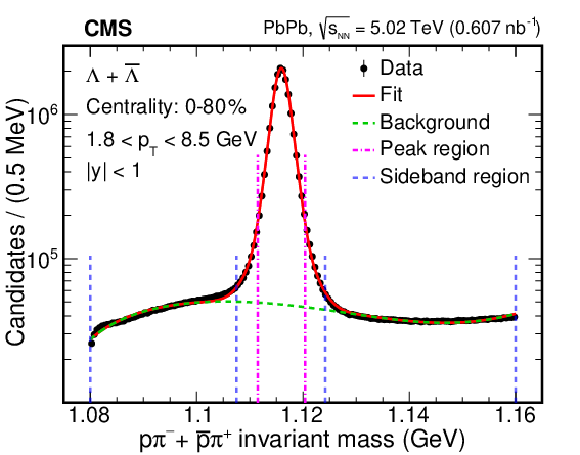
png pdf |
Figure 1-b:
The invariant mass of $ \Lambda $, and the corresponding fit in the 0-80% centrality range. The circles are the data, and the fit is shown with a solid (red) line for the total fit, and a dashed (green) line for the background fit. The vertical dashed-dotted (pink) lines indicate the peak region and the vertical dashed (blue) lines indicate the sideband regions. |
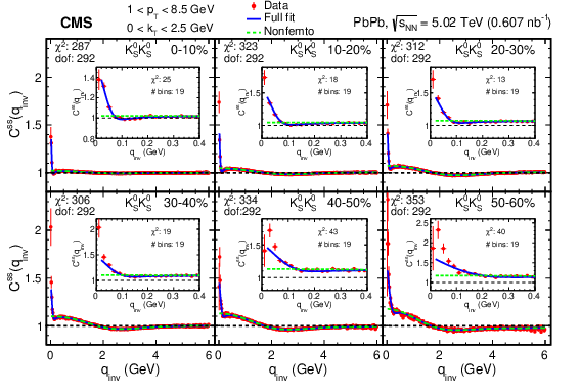
png pdf |
Figure 2:
The correlation distributions and fits for $ \mathrm{K^0_S}\mathrm{K^0_S} $ pairs in different centrality ranges, starting from 0-10% centrality to 50-60% centrality, with 0 $ < k_{\mathrm{T}} < $ 2.5 GeV. In each plot, the red circles are the data, the blue solid line is the fit using Eq. (8), and the green dotted line is the non-femtoscopic background from Eq. (7). The $ \chi^2 $ and dof values are for the full $ q_{\text{inv}} $ range. The insert plots show the data and the fit for the $ q_{\text{inv}} < $ 0.4 GeV region, with the $ \chi^2 $ and number of bins evaluated in that region. |
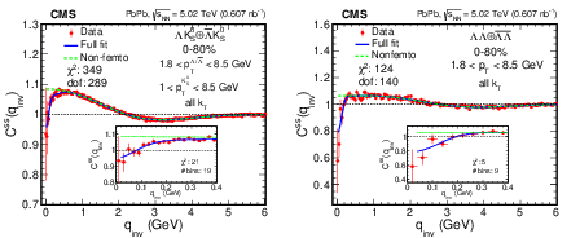
png pdf |
Figure 3:
The correlation distributions and fits for $ \Lambda\mathrm{K^0_S} $ (left) and $ \Lambda\Lambda $ (right) pairs with 0-80% centrality and no restriction on $ k_{\mathrm{T}} $. In each plot, the red circles are the data, the blue solid line is the fit using Eq. (8), and the green dotted line is the non-femtoscopic background from Eq. (7). The $ \chi^2 $ and dof values are for the full $ q_{\text{inv}} $ range. The insert plots show the data and the fit for the $ q_{\text{inv}} < $ 0.4 GeV region, with the $ \chi^2 $ and number of bins evaluated in that region. |
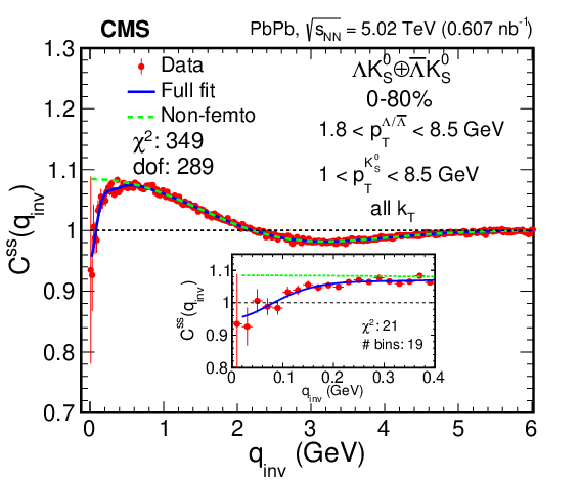
png pdf |
Figure 3-a:
The correlation distributions and fits for $ \Lambda\mathrm{K^0_S} $ $ \Lambda\Lambda $ pairs with 0-80% centrality and no restriction on $ k_{\mathrm{T}} $. The red circles are the data, the blue solid line is the fit using Eq. (8), and the green dotted line is the non-femtoscopic background from Eq. (7). The $ \chi^2 $ and dof values are for the full $ q_{\text{inv}} $ range. The insert plot shows the data and the fit for the $ q_{\text{inv}} < $ 0.4 GeV region, with the $ \chi^2 $ and number of bins evaluated in that region. |

png pdf |
Figure 3-b:
The correlation distributions and fits for $ \Lambda\mathrm{K^0_S} $ (left) and $ \Lambda\Lambda $ (right) pairs with 0-80% centrality and no restriction on $ k_{\mathrm{T}} $. In each plot, the red circles are the data, the blue solid line is the fit using Eq. (8), and the green dotted line is the non-femtoscopic background from Eq. (7). The $ \chi^2 $ and dof values are for the full $ q_{\text{inv}} $ range. The insert plots show the data and the fit for the $ q_{\text{inv}} < $ 0.4 GeV region, with the $ \chi^2 $ and number of bins evaluated in that region. |
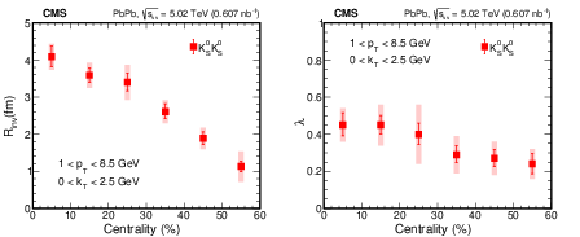
png pdf |
Figure 4:
The $ R_{\text{inv}} $ (left) and $ \lambda $ parameter (right) as a function of centrality. For each data point, the line and shaded area indicate the statistical and systematic uncertainty, respectively. |
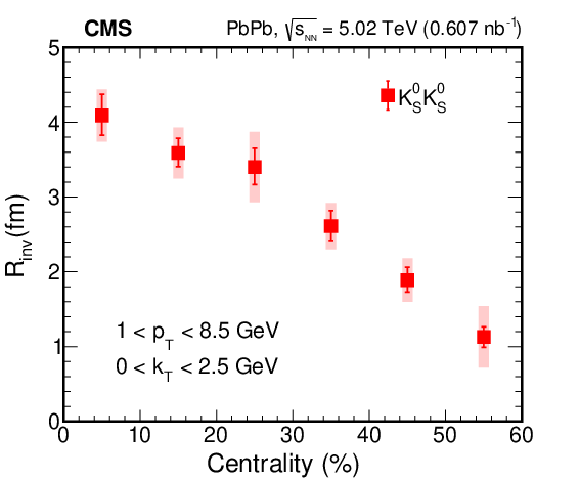
png pdf |
Figure 4-a:
The $ R_{\text{inv}} $ parameter as a function of centrality. For each data point, the line and shaded area indicate the statistical and systematic uncertainty, respectively. |
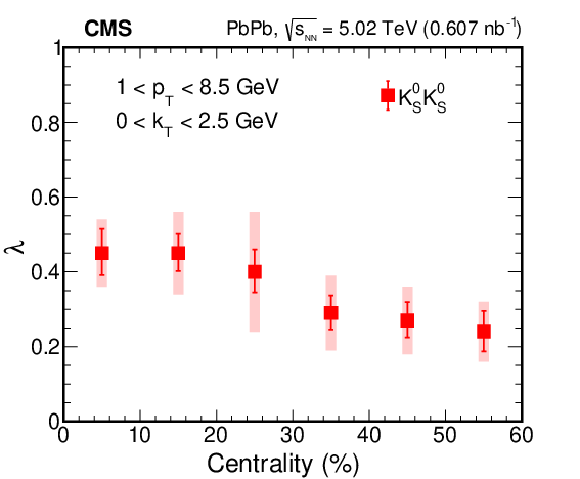
png pdf |
Figure 4-b:
The $ \lambda $ parameter as a function of centrality. For each data point, the line and shaded area indicate the statistical and systematic uncertainty, respectively. |
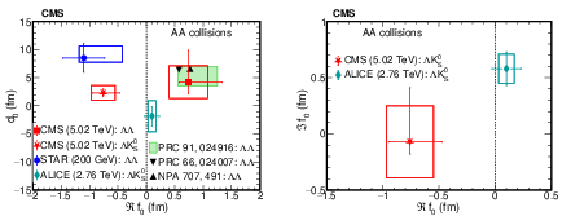
png pdf |
Figure 5:
The measured values of $ d_0 $ versus $ \Re \, f_0 $ (left) and $ \Im \, f_0 $ versus $ \Re \, f_0 $ (right) from this analysis along with other measurements and predictions as described in the text. For each data point, the lines and the boxes indicate the (one-dimensional) statistical and systematic uncertainties, respectively. |
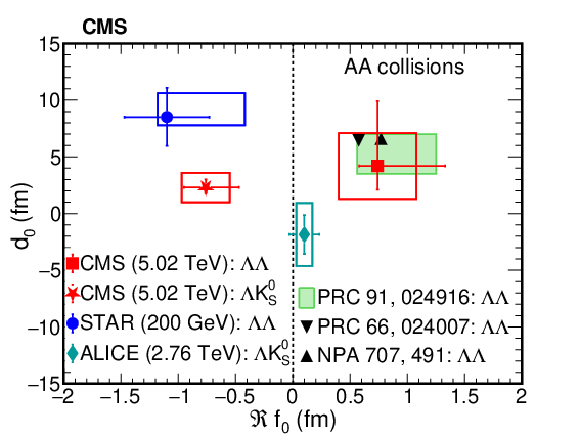
png pdf |
Figure 5-a:
The measured values of $ d_0 $ versus $ \Re \, f_0 $ (left) and $ \Im \, f_0 $ versus $ \Re \, f_0 $ (right) from this analysis along with other measurements and predictions as described in the text. For each data point, the lines and the boxes indicate the (one-dimensional) statistical and systematic uncertainties, respectively. |

png pdf |
Figure 5-b:
The measured values of $ d_0 $ versus $ \Re \, f_0 $ (left) and $ \Im \, f_0 $ versus $ \Re \, f_0 $ (right) from this analysis along with other measurements and predictions as described in the text. For each data point, the lines and the boxes indicate the (one-dimensional) statistical and systematic uncertainties, respectively. |
| Tables | |

png pdf |
Table 1:
Summary of absolute systematic uncertainties in $ \mathrm{K^0_S}\mathrm{K^0_S} $, $ \Lambda\mathrm{K^0_S} $ and $ \Lambda\Lambda $ correlation measurements. The values for $ R_{\text{inv}} $, $ d_0 $, $ \Re \, f_0 $, and $ \Im \, f_0 $ are in fm. |
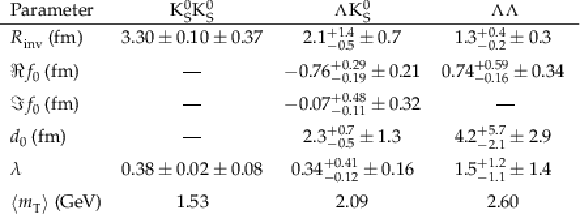
png pdf |
Table 2:
Extracted values of the $ R_{\text{inv}} $, $ \Re \, f_0 $, $ \Im \, f_0 $, $ d_0 $, $ \lambda $, and $ \left < m_{\mathrm{T}}\right > $ parameters from the $ \mathrm{K^0_S}\mathrm{K^0_S} $, $ \Lambda\mathrm{K^0_S} $, and $ \Lambda\Lambda $ combinations in the 0-80% centrality range. The first and second uncertainties are statistical and systematic, respectively. |
| Summary |
| The $ \mathrm{K^0_S}\mathrm{K^0_S} $, $ \Lambda\mathrm{K^0_S} $, and $ \Lambda\Lambda $ femtoscopic correlations are studied using lead-lead (PbPb) collision data at a center-of-mass energy per nucleon pair of $ \sqrt{\smash[b]{s_{_{\mathrm{NN}}}}} = $ 5.02 TeV, collected by the CMS Collaboration. This is the first report on $ \Lambda\Lambda $ correlations in PbPb collisions at the CERN LHC. The source size $ R_{\text{inv}} $ and the incoherence parameter $ \lambda $ were extracted for $ \mathrm{K^0_S}\mathrm{K^0_S} $ correlations in six centrality bins covering the 0-60% range. The value of $ R_{\text{inv}} $ decreases from 4 to 1 fm going from central to peripheral collisions and agrees with results from the ALICE Collaboration at a similar transverse mass. Along with the $ R_{\text{inv}} $ and $ \lambda $ parameters, the strong interaction scattering parameters, i.e.,, the complex scattering length and effective range, were extracted from $ \Lambda\mathrm{K^0_S} $ and $ \Lambda\Lambda $ correlations in the 0-80% centrality range. These scattering parameters indicate that the $ \Lambda\mathrm{K^0_S} $ interaction is repulsive and that the $ \Lambda\Lambda $ interaction is attractive. The scattering parameters obtained from $ \Lambda\mathrm{K^0_S} $ correlations differ from those reported by the ALICE Collaboration. The positive real scattering length obtained from the $ \Lambda\Lambda $ correlation disfavors the existence of a bound H-dibaryon state. The $ \Lambda\Lambda $ scattering parameters help to constrain baryon-baryon and, more specifically, hyperon-hyperon interaction models. These measurements provide an additional input to understand the nature of the strong interaction between pairs of strange hadrons. |
| References | ||||
| 1 | M. A. Lisa, S. Pratt, R. Soltz, and U. Wiedemann | Femtoscopy in relativistic heavy ion collisions: Two decades of progress | Ann. Rev. Nucl. Part. Sci. 55 (2005) 357 | nucl-ex/0505014 |
| 2 | V. G. J. Stoks, R. A. M. Klomp, M. C. M. Rentmeester, and J. J. de Swart | Partial-wave analysis of all nucleon-nucleon scattering data below 350 MeV | Phys. Rev. C 48 (1993) 792 | |
| 3 | J. J. de Swart and C. Dullemond | Effective range theory and the low energy hyperon-nucleon interactions | Anna. Phys. 19 (1962) 458 | |
| 4 | R. Engelmann, H. Filthuth, V. Hepp, and E. Kluge | Inelastic $ \Sigma^{-} \mathrm{p} $-interactions at low momenta | PL 21 (1966) 587 | |
| 5 | F. Eisele et al. | Elastic $ \Sigma^{\pm} \mathrm{p} $ scattering at low energies | PLB 37 (1971) 204 | |
| 6 | B. Sechi-Zorn, B. Kehoe, J. Twitty, and R. A. Burnstein | Low-energy $ \Lambda $-proton elastic scattering | PR 175 (1968) 1735 | |
| 7 | CMS Collaboration | Bose--Einstein correlations in pp, pPb, and PbPb collisions at $ \sqrt{\smash[b]{s_{_{\mathrm{NN}}}}} = $ 0.9-7 TeV | Phys. Rev. C 97 (2018) 064912 | CMS-FSQ-14-002 1712.07198 |
| 8 | J. Schaffner-Bielich, M. Hanauske, H. Stöcker, and W. Greiner | Phase transition to hyperon matter in neutron stars | PRL 89 (2002) 171101 | astro-ph/0005490 |
| 9 | K. Morita, T. Furumoto, and A. Ohnishi | $ \Lambda\Lambda $ interaction from relativistic heavy-ion collisions | Phys. Rev. C 91 (2015) 024916 | 1408.6682 |
| 10 | ALICE Collaboration | Study of the $ \Lambda$-$\Lambda $ interaction with femtoscopy correlations in pp and pPb collisions at the LHC | PLB 797 (2019) 134822 | 1905.07209 |
| 11 | R. L. Jaffe | Perhaps a stable dihyperon | PRL 38 (1977) 195 | |
| 12 | H. Takahashi et al. | Observation of a $ ^{\;\;\;\;6}_{\Lambda\Lambda}{\mathrm{He}} $ double hypernucleus | PRL 87 (2001) 212502 | |
| 13 | K. Nakazawa and H. Takahashi | Experimental study of double-$ \Lambda $ hypernuclei with nuclear emulsion | Prog. Theor. Phys. Supplement 185 (2010) 335 | |
| 14 | Belle Collaboration | Search for an $ H $-dibaryon with a mass near 2 $ {m}_{\Lambda} $ in $ \Upsilon{\textrm{(1S)}} $ and $ \Upsilon{\textrm{(2S)}} $ decays | PRL 110 (2013) 222002 | 1302.4028 |
| 15 | ALICE Collaboration | $ \Lambda\mathrm{K} $ femtoscopy in Pb-Pb collisions at $ \sqrt{\smash[b]{s_{_{\mathrm{NN}}}}} = $ 2.76 TeV | Phys. Rev. C 103 (2021) 055201 | 2005.11124 |
| 16 | C. Loizides, J. Kamin, and D. d'Enterria | Improved Monte Carlo Glauber predictions at present and future nuclear colliders | Phys. Rev. C 97 (2018) 054910 | 1710.07098 |
| 17 | R. Lednicky and V. L. Lyuboshitz | Final state interaction effect on pairing correlations between particles with small relative momenta | Sov. J. Nucl. Phys. 35 (1982) 770 | |
| 18 | CMS Collaboration | HEPData record for this analysis | link | |
| 19 | Tracker Group of the CMS Collaboration | The CMS phase-1 pixel detector upgrade | JINST 16 (2021) P02027 | 2012.14304 |
| 20 | CMS Collaboration | Track impact parameter resolution for the full pseudorapidity coverage in the 2017 dataset with the CMS phase-1 pixel detector | CMS Detector Performance Note CMS-DP-2020-049, 2020 CDS |
|
| 21 | CMS Collaboration | Performance of the CMS level-1 trigger in proton-proton collisions at $ \sqrt{s} = $ 13 TeV | JINST 15 (2020) P10017 | CMS-TRG-17-001 2006.10165 |
| 22 | CMS Collaboration | The CMS trigger system | JINST 12 (2017) 01020 | CMS-TRG-12-001 1609.02366 |
| 23 | CMS Collaboration | The CMS experiment at the CERN LHC | JINST 3 (2008) S08004 | |
| 24 | CMS Collaboration | Precision luminosity measurement in proton-proton collisions at $ \sqrt{s} = $ 13 TeV in 2015 and 2016 at CMS | EPJC 81 (2021) 800 | CMS-LUM-17-003 2104.01927 |
| 25 | CMS Collaboration | CMS luminosity measurement using nucleus-nucleus collisions at $ \sqrt{\smash[b]{s_{_{\mathrm{NN}}}}} = $ 5.02 TeV in 2018 | CMS Physics Analysis Summary, 2022 CMS-PAS-LUM-18-001 |
CMS-PAS-LUM-18-001 |
| 26 | CMS Collaboration | Charged-particle nuclear modification factors in PbPb and pPb collisions at $ \sqrt{\smash[b]{s_{_{\mathrm{NN}}}}} = $ 5.02 TeV | JHEP 04 (2017) 039 | CMS-HIN-15-015 1611.01664 |
| 27 | CMS Collaboration | Description and performance of track and primary-vertex reconstruction with the CMS tracker | JINST 9 (2014) P10009 | CMS-TRK-11-001 1405.6569 |
| 28 | CMS Collaboration | Transverse-momentum and pseudorapidity distributions of charged hadrons in pp collisions at $ \sqrt{s} = $ 0.9 and 2.36 TeV | JHEP 02 (2010) 041 | CMS-QCD-09-010 1002.0621 |
| 29 | CMS Collaboration | Observation and studies of jet quenching in PbPb collisions at nucleon-nucleon $ \sqrt{\smash[b]{s_{_{\mathrm{NN}}}}} = $ 2.76 TeV | Phys. Rev. C 84 (2011) 024906 | CMS-HIN-10-004 1102.1957 |
| 30 | C. Gale, S. Jeon, and B. Schenke | Hydrodynamic modeling of heavy ion collisions | Int. J. Mod. Phys. A 28 (2013) 1340011 | 1301.5893 |
| 31 | GEANT4 Collaboration | GEANT 4---a simulation toolkit | NIM A 506 (2003) 250 | |
| 32 | CMS Collaboration | Strange hadron collectivity in pPb and PbPb collisions | CMS-HIN-19-004 2205.00080 |
|
| 33 | CMS Collaboration | Strange particle production in pp collisions at $ \sqrt{s} = $ 0.9 and 7 TeV | JHEP 05 (2011) 064 | CMS-QCD-10-007 1102.4282 |
| 34 | CMS Collaboration | Long-range two-particle correlations of strange hadrons with charged particles in pPb and PbPb collisions at LHC energies | PLB 742 (2015) 200 | CMS-HIN-14-002 1409.3392 |
| 35 | Particle Data Group Collaboration | Review of particle physics | Prog. Theor. Exp. Phys. 2022 (2022) 083C01 | |
| 36 | H. Voss, A. Höcker, J. Stelzer, and F. Tegenfeldt | TMVA, the toolkit for multivariate data analysis with ROOT | in XIth International Workshop on Advanced Computing and Analysis Techniques in Physics Research (ACAT), 2007 link |
physics/0703039 |
| 37 | G. I. Kopylov | Like particle correlations as a tool to study the multiple production mechanism | PLB 50 (1974) 472 | |
| 38 | A. Kisiel | Non-identical particle correlation analysis in the presence of non-femtoscopic correlations | Acta Phys. Polon. B 48 (2017) 717 | |
| 39 | ALICE Collaboration | pp, p-$ \Lambda $, and $ \Lambda$-$\Lambda $ correlations studied via femtoscopy in pp reactions at $ \sqrt{s} = $ 7 TeV | Phys. Rev. C 99 (2019) 024001 | 1805.12455 |
| 40 | STAR Collaboration | Neutral kaon interferometry in Au+Au collisions at $ \sqrt{\smash[b]{s_{_{\mathrm{NN}}}}} = $ 200 GeV | Phys. Rev. C 74 (2006) 054902 | nucl-ex/0608012 |
| 41 | A. D. Martin and E. N. Ozmutlu | Analyses of $ \mathrm{K}\mathrm{K} $ production and scalar mesons | NPB 158 (1979) 520 | |
| 42 | A. Antonelli | Radiative $ \phi $ decays | ConfC 020620 (2002) THAT06 | hep-ex/0209069 |
| 43 | N. N. Achasov and V. V. Gubin | Analysis of the nature of the $ \phi\to\gamma\pi\eta $ and $ \phi\to\gamma\pi^{0}\pi^{0} $ decays | PRD 63 (2001) 094007 | hep-ph/0101024 |
| 44 | N. N. Achasov and A. V. Kiselev | New analysis of the KLOE data on the $ \phi\to\eta\pi^{0}\gamma $ decay | PRD 68 (2003) 014006 | hep-ph/0212153 |
| 45 | F. James and M. Roos | Minuit: A system for function minimization and analysis of the parameter errors and correlations | Comput. Phys. Commun. 10 (1975) 343 | |
| 46 | PHENIX Collaboration | Lévy-stable two-pion Bose--Einstein correlations in $ \sqrt{\smash[b]{s_{_{\mathrm{NN}}}}} = $ 200 GeV Au+Au collisions | Phys. Rev. C 97 (2018) 064911 | 1709.05649 |
| 47 | ALICE Collaboration | One-dimensional pion, kaon, and proton femtoscopy in Pb-Pb collisions at $ \sqrt{\smash[b]{s_{_{\mathrm{NN}}}}} = $ 2.76 TeV | Phys. Rev. C 92 (2015) 054908 | 1506.07884 |
| 48 | STAR Collaboration | $ \Lambda\Lambda $ correlation function in Au+Au collisions at $ \sqrt{\smash[b]{s_{_{\mathrm{NN}}}}} = $ 200 GeV | PRL 114 (2015) 022301 | 1408.4360 |
| 49 | E. Hiyama et al. | Four-body cluster structure of $ \mathrm{A} = $ 7-10 double-$ \Lambda $ hypernuclei | Phys. Rev. C 66 (2002) 024007 | nucl-th/0204059 |
| 50 | I. N. Filikhin and A. Gal | Faddeev-Yakubovsky calculations for light $ \Lambda\Lambda $ hypernuclei | Nucl. Phys. A 707 (2002) 491 | nucl-th/0203036 |

|
Compact Muon Solenoid LHC, CERN |

|

|

|

|

|

|